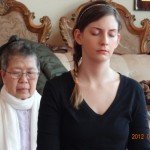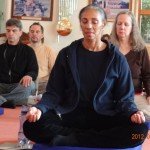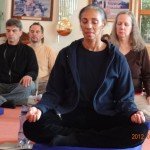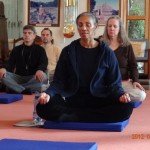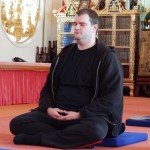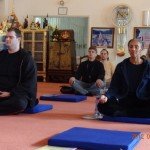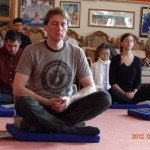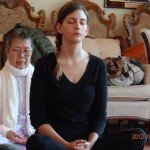The
first step one takes in becoming a Buddhist is the taking of refuge. The
act of taking refuge goes back to the very earliest period of the Buddhist
community. The first record of this in fact comes from the weeks
following the Buddha’s Enlightenment when we are told that two merchants who
were passing through the place where he attained Enlightenment took refuge in
the Buddha and Dharma. At that stage it was a two-fold refuge as at that
time the Sangha was not yet formed. Following upon this we find
references to the taking of the three-fold refuge. This was shortly
after the Buddha began his teaching career at Sarnath. We have the
conversion of Yasha, the son of a wealthy family of Benares. After Yasa’s
conversion, we have the conversion of Yasha’s family, and according to
tradition, Yasa’s family were the first lay followers to take the three-fold
refuge in the Buddha, Dharma and Sangha.
The
taking of refuge is extremely important within the Buddhist community both as a
mark of entry into the Buddhist community for the laity, and also as a part of
the ordination ceremony for monks and nuns. We know, for instance, that
for a long time before the more elaborate ordination ceremony came into
fashion, monks were admitted into the Buddhist monastic community with a
relatively simple ceremony. The most important element of that ceremony
was the recitation of the three-fold refuge formula thrice. From that
time until the present, the taking of refuge has become a very important part
of becoming a Buddhist. That is why the taking of refuge is the first
formal step one takes in becoming a Buddhist.
What
are the motivations for taking refuge? Traditionally there are three –
fear, faith and compassion. The three motivations correspond to three
types of individuals. The individual who takes refuge out of fear
represents the least developed type of individual. The individual who
takes refuge out of faith represents the individual of medium
development. And the individual who takes refuge out of compassion
represents the individual of greatest development.
Fear
is a universal and well known motivation for all kinds of action.
Particularly in the religious context, it is the basic motivation for most of
the religious activities, indeed for the birth of religion itself. It is
a fact that some of the earliest manifestations of religious behavior, for
example, sacrifices, magical rites and so forth were performed out of
fear. Believing that they were surrounded by forces that they could not
control, men reacted with fear and tried to do something about it. In the
context of refuge, it is the fear of rebirth and suffering.
Faith
is a more positive motivation than fear because one is not simply driven in a
negative way. One is instead drawn in a positive way because one sees
special qualities in the Triple Gem and has faith in those qualities.
Faith in the Buddhist context is not blind faith. It is not reliance upon
grace or the power of another. It is simply that positive attitude of the
mind which believes that success is possible. In other words, we will not
succeed in whatever we undertake with a negative attitude.
The
highest of the motivations extends one’s interest beyond one’s concern for
oneself to the concern for all living beings. This person goes to refuge
out of compassion, to help all living beings from their suffering.
We
can illustrate the working of these three motivations by means of a very simple
example. Suppose you are walking down the street and you are suddenly caught
in a very heavy downpour. Your first reaction will be one of fear, and
you will look for shelter. Once you have been impressed with the
necessity to find a shelter, you will look around for a shelter. In that
situation, you will need to have faith in the shelter. You will not have
much faith if it is just a temporary canopy because they may collapse or you
may be electrocuted. But if you see a solid apartment block you will have
faith in its ability to protect you. You will go into that building for
refuge. This is analogous to taking refuge out of faith. Once you
have decided to seek refuge in the building, you will want to call to other
passers-by to take refuge in the same building. This is analogous to
taking refuge out of compassion. This illustrates the different levels of
motivation in taking refuge, from a very narrow and negative motivation to a
positive one and finally to a universal motivation.
The
three objects of refuge are the Buddha, Dharma and Sangha. The Buddha is
called the supreme Teacher of gods and men, the Enlightened One, the Arhat and
so forth. These qualities of the Buddha make him a worthy object of
refuge.
Similarly,
the Dharma also has many qualities that make it an object worthy of
refuge. The Dharma is taught without any selfish motivation. It is
taught simply to benefit all living beings. The Dharma is intrinsically
pure. It is like a light which dispels darkness. Specifically, the
Dharma can be divided into two aspects — the Dharma which one becomes familiar
with through indirect means like reading and listening, and the Dharma which
one becomes familiar with through direct, personal realization through one’s
own meditative and living experience.
As
regards the Sangha, some believe that it refers only to the community of monks,
while others believe that it refers to the whole Buddhist community.
While both interpretations are correct, in the context of the three-fold
refuge, the Sangha refers to the Noble Community. This refers to either
the four noble types of persons — Stream-winner, Once-Returner, Non-Returner
and Arhat, or the community of irreversible Bodhisattvas.
One
relates to the objects of refuge in particular ways. One relates to the
Buddha as one’s guide, the Dharma as one’s path, and the Sangha as one’s
travelling companions. In this context, one can think of achieving
Enlightenment as taking a journey to a distant place. In order to do so
successfully, one would need a guide, a path and travelling companion to cheer
one up when one is lonely or depressed. The Buddha is the ideal guide
because he has traveled the path before. He can lead others to the goal
as he has achieved the goal himself.
The
Dharma is the ideal path laid down by the Buddha because it has been designed
to overcome obstacles of various kinds. Just as one might build a bridge
to cross a chasm, the Dharma supplies teaching regarding good conduct to get
over unwholesome actions. Just as the path might provide handrails to
keep us from being blown off by the wind, the Dharma provides us the techniques
to overcome the distractions to meditation. And just as the path might
provide street lamps to light the way, the teaching on wisdom lights the way so
that we do not go astray from the path.
The
Sangha are the ideal travelling companions because they share our general
orientation, and because they have achieved certain mastery of the path,
especially the Noble Sangha. They are in a position to help us
along. Even the ordinary worldly Buddhist community can be a support
because we tend to be discouraged and tired if we undertake to do anything
alone.
The
taking of refuge has traditionally been formalized in the form of a ceremony or
ritual. This dates back to the very earliest period of the Buddhist
community and has continued to function in that form till today. The
taking of refuge has two functions. Firstly, it marks one’s first and
formal entry into the Buddhist community. After that we continue to take
refuge daily as an indication of our commitment as Buddhists towards achieving
Enlightenment by following the path. This act of taking refuge is
usually performed before a monk, a master, or an image of the Buddha. It
is an indication that we are following a continuous living tradition handed down
from the time of the Buddha. The refuge formula is repeated thrice
because the number three is the smallest plural number which symbolically
stands for innumerable recitations.
Secondly,
the taking of refuge brings about many benefits. As the first step on the
path, it opens the door to all the practices in the Buddhist tradition.
It gives one a definite positive direction in which to move. In this way,
it creates the conditions for the realization of countless benefits. In
as much as the taking of refuge is the first step on one’s path to
Enlightenment, all the benefits of Enlightenment result directly or indirectly
from the taking of refuge. It also gives one safety from rebirth in the
lower realms.
But
the taking of refuge also requires some commitments, just as when you become a
member of a club you have to observe certain rules and regulations, or when you
become a citizen of a country, you have to follow the rules of the
country. The rules and regulations of refuge are the five precepts.
They embody the respect for life, property, personal relationship, truth and
mental health.


